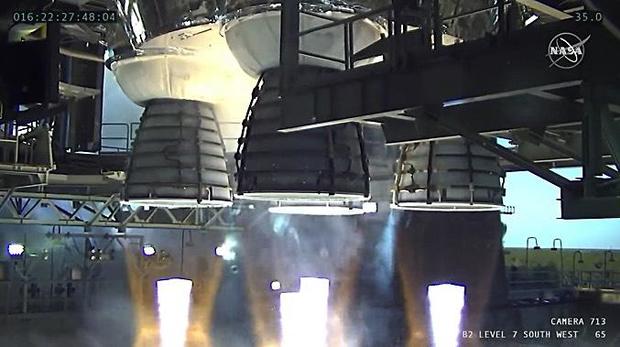Engineers reviewing data from an aborted first stage test firing of NASA’s Artemis moon rocket have decided to carry out a second “hot fire” test of the huge booster toward the end of February, the agency announced Friday.
Assuming the retest at NASA’s Stennis Space Center in Mississippi goes well, it will take about a month to prepare the Space Launch System rocket’s first stage for shipment to the Kennedy Space Center in Florida where it will be prepared for launch on an unpiloted test flight.
That long-awaited maiden flight had been planned for late this year. NASA has not yet announced a target launch date that takes the retest into account, but it appears likely to slip into early 2022 given the time lost carrying out a second “green run” test firing and required post-test servicing.
NASA originally planned to ship the rocket in February following a planned eight-minute test firing on January 16.
Firmly locked down on the massive B-2 test stand at Stennis, the huge rocket’s four shuttle-heritage Aerojet Rocketdyne main engines ignited and throttled up to full power as planned, generating a combined 1.8 million pounds of thrust.
Then, about a minute into the run, hydraulic pressure readings in the “thrust vector control” steering system used to move, or gimbal, the engine nozzles dropped just below pre-set limits and the rocket’s computer system ordered an early shutdown.
Telemetry also indicated an unrelated problem with an electrical harness used by instrumentation monitoring engine No. 4, but there was no impact on engine operation and the issue was unrelated to the abort.
As it turned out, the hydraulic system software limits were in place for the ground test and would not have been a factor during an actual launch. The rocket, its engines and the test stand were not damaged.
After reviewing telemetry and inspecting the hardware, engineers opted to carry out another test firing, this one lasting at least four minutes, to verify the rocket’s systems will work as planned during flight. The hydraulic system software will be adjusted and the suspect electrical harness replaced.
“After evaluating data from the first hot fire (and earlier subsystem tests), NASA and core stage lead contractor Boeing determined that a second, longer hot fire test should be conducted and would pose minimal risk to the Artemis 1 core stage while providing valuable data to help certify the core stage for flight,” NASA said in a statement.
“Conducting a second hot fire test will allow the team to repeat operations from the first hot fire test and obtain data on how the core stage and the engines perform over a longer period that simulates more activities during the rocket’s launch and ascent.”
The SLS rocket being developed for the Artemis moon program will be the most powerful ever built. The first stage engines, along with two Northrop Grumman solid-fuel boosters, will generate a combined 8.8 million pounds of thrust at liftoff. A hydrogen-fueled second stage will propel the Orion spacecraft to the moon.
After the Artemis 1 test flight, NASA plans to launch a second SLS rocket to boost four Orion astronauts on a deep space mission beyond the moon to thoroughly test the capsule and its flight control, life support and other systems.
The third Artemis mission, planned under a Trump administration mandate, called for landing two astronauts near the south pole of the moon by the end of 2024.
But Congress has not yet fully funded the required lunar lander, making the 2024 target virtually impossible to meet. NASA, meanwhile, is awaiting guidance from the Biden administration, which has not yet revealed what its space priorities might be.


